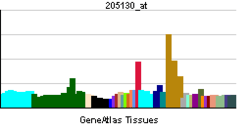RAGE (gene)
| MOK protein kinase | |||||||||||||
|---|---|---|---|---|---|---|---|---|---|---|---|---|---|
| Identifiers | |||||||||||||
| Symbols | MOK ; RAGE; RAGE-1; RAGE1; STK30 | ||||||||||||
| External IDs | OMIM: 605762 MGI: 1347040 HomoloGene: 8062 GeneCards: MOK Gene | ||||||||||||
| EC number | 2.7.11.22 | ||||||||||||
| |||||||||||||
| RNA expression pattern | |||||||||||||
 | |||||||||||||
| More reference expression data | |||||||||||||
| Orthologs | |||||||||||||
| Species | Human | Mouse | |||||||||||
| Entrez | 5891 | 26448 | |||||||||||
| Ensembl | ENSG00000080823 | ENSMUSG00000056458 | |||||||||||
| UniProt | Q9UQ07 | Q9WVS4 | |||||||||||
| RefSeq (mRNA) | NM_001272011 | NM_011973 | |||||||||||
| RefSeq (protein) | NP_001258940 | NP_036103 | |||||||||||
| Location (UCSC) |
Chr 14: 102.22 – 102.31 Mb |
Chr 12: 110.81 – 110.84 Mb | |||||||||||
| PubMed search | |||||||||||||
MAPK/MAK/MRK overlapping kinase is an enzyme that in humans is encoded by the RAGE gene.[1][2][3]
References
- ↑ Gaugler B, Brouwenstijn N, Vantomme V, Szikora JP, Van der Spek CW, Patard JJ, Boon T, Schrier P, Van den Eynde BJ (Oct 1996). "A new gene coding for an antigen recognized by autologous cytolytic T lymphocytes on a human renal carcinoma". Immunogenetics 44 (5): 323–30. doi:10.1007/BF02602776. PMID 8781117.
- ↑ Miyata Y, Akashi M, Nishida E (Aug 1999). "Molecular cloning and characterization of a novel member of the MAP kinase superfamily". Genes Cells 4 (5): 299–309. doi:10.1046/j.1365-2443.1999.00261.x. PMID 10421840.
- ↑ "Entrez Gene: RAGE renal tumor antigen".
Further reading
- Eichmüller S, Usener D, Jochim A, Schadendorf D (2003). "mRNA expression of tumor-associated antigens in melanoma tissues and cell lines.". Exp. Dermatol. 11 (4): 292–301. doi:10.1034/j.1600-0625.2002.110402.x. PMID 12190937.
- Götte K, Usener D, Riedel F, et al. (2003). "Tumor-associated antigens as possible targets for immune therapy in head and neck cancer: comparative mRNA expression analysis of RAGE and GAGE genes.". Acta Otolaryngol. 122 (5): 546–52. doi:10.1080/00016480260092381. PMID 12206267.
- Strausberg RL, Feingold EA, Grouse LH, et al. (2003). "Generation and initial analysis of more than 15,000 full-length human and mouse cDNA sequences.". Proc. Natl. Acad. Sci. U.S.A. 99 (26): 16899–903. doi:10.1073/pnas.242603899. PMC 139241. PMID 12477932.
- Yan M, Ghorab Z, Nadji M (2004). "Renal cell carcinoma antigen is expressed by yolk sac tumors and yolk sac elements of embryonal carcinomas.". Appl. Immunohistochem. Mol. Morphol. 11 (2): 113–5. doi:10.1097/00129039-200306000-00003. PMID 12777992.
- Ota T, Suzuki Y, Nishikawa T, et al. (2004). "Complete sequencing and characterization of 21,243 full-length human cDNAs.". Nat. Genet. 36 (1): 40–5. doi:10.1038/ng1285. PMID 14702039.
- Miura J, Uchigata Y, Yamamoto Y, et al. (2004). "AGE down-regulation of monocyte RAGE expression and its association with diabetic complications in type 1 diabetes.". J. Diabetes Complicat. 18 (1): 53–9. doi:10.1016/S1056-8727(02)00281-7. PMID 15019601.
- Rudofsky G, Isermann B, Schilling T, et al. (2004). "A 63bp deletion in the promoter of rage correlates with a decreased risk for nephropathy in patients with type 2 diabetes.". Exp. Clin. Endocrinol. Diabetes 112 (3): 135–41. doi:10.1055/s-2004-817822. PMID 15052533.
- Uesaka T, Kageyama N (2004). "Cdx2 homeodomain protein regulates the expression of MOK, a member of the mitogen-activated protein kinase superfamily, in the intestinal epithelial cells.". FEBS Lett. 573 (1–3): 147–54. doi:10.1016/j.febslet.2004.07.070. PMID 15327990.
- Gerhard DS, Wagner L, Feingold EA, et al. (2004). "The status, quality, and expansion of the NIH full-length cDNA project: the Mammalian Gene Collection (MGC)". Genome Res. 14 (10B): 2121–7. doi:10.1101/gr.2596504. PMC 528928. PMID 15489334.
- Bierhaus A, Haslbeck KM, Humpert PM, et al. (2005). "Loss of pain perception in diabetes is dependent on a receptor of the immunoglobulin superfamily". J. Clin. Invest. 114 (12): 1741–51. doi:10.1172/JCI200418058. PMC 535062. PMID 15599399.
- Grunau C, Sanchez C, Ehrlich M, et al. (2005). "Frequent DNA hypomethylation of human juxtacentromeric BAGE loci in cancer". Genes Chromosomes Cancer 43 (1): 11–24. doi:10.1002/gcc.20155. PMID 15704127.
- dos Santos KG, Canani LH, Gross JL, et al. (2005). "The -374A allele of the receptor for advanced glycation end products gene is associated with a decreased risk of ischemic heart disease in African-Brazilians with type 2 diabetes". Mol. Genet. Metab. 85 (2): 149–56. doi:10.1016/j.ymgme.2005.02.010. PMID 15896660.
- Oehlrich N, Devitt G, Linnebacher M, et al. (2005). "Generation of RAGE-1 and MAGE-9 peptide-specific cytotoxic T-lymphocyte lines for transfer in patients with renal cell carcinoma". Int. J. Cancer 117 (2): 256–64. doi:10.1002/ijc.21200. PMID 15900605.
- Dumitriu IE, Baruah P, Bianchi ME, et al. (2005). "Requirement of HMGB1 and RAGE for the maturation of human plasmacytoid dendritic cells". Eur. J. Immunol. 35 (7): 2184–90. doi:10.1002/eji.200526066. PMID 15915542.
- Haslbeck KM, Friess U, Schleicher ED, et al. (2007). "The RAGE pathway in inflammatory myopathies and limb girdle muscular dystrophy". Acta Neuropathol. 110 (3): 247–54. doi:10.1007/s00401-005-1043-3. PMID 15986224.
- Ramprasad S, Radha V, Mathias RA, et al. (2007). "Rage gene promoter polymorphisms and diabetic retinopathy in a clinic-based population from South India". Eye (London, England) 21 (3): 395–401. doi:10.1038/sj.eye.6702239. PMID 16440015.
- Lindholm E, Bakhtadze E, Sjögren M, et al. (2007). "The -374 T/A polymorphism in the gene encoding RAGE is associated with diabetic nephropathy and retinopathy in type 1 diabetic patients". Diabetologia 49 (11): 2745–55. doi:10.1007/s00125-006-0412-3. PMID 16969646.
- Dumitriu IE, Bianchi ME, Bacci M, et al. (2007). "The secretion of HMGB1 is required for the migration of maturing dendritic cells". J. Leukoc. Biol. 81 (1): 84–91. doi:10.1189/jlb.0306171. PMID 17035340.
This article is issued from Wikipedia - version of the Wednesday, September 02, 2015. The text is available under the Creative Commons Attribution/Share Alike but additional terms may apply for the media files.